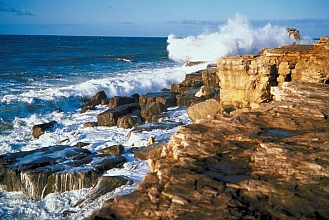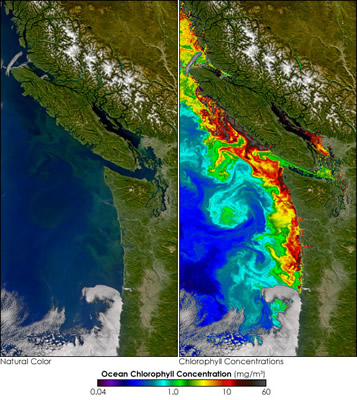Scientists are discovering why blooms of harmful algae are often seen along the U.S. Northwest Coast. This image was taken on September 29, 2004 and shows a large bloom of Pseudo-nitzschia, a toxic algae, off the Strait of Juan de Fuca.
Click on image for full size
Image Courtesy of the SeaWiFS Project, NASA/Goddard Space Flight Center, and ORBIMAGE.
"Hot Spot" for Toxic Algal Blooms Discovered off Washington Coast
News story originally written on January 30, 2009
Scientists are trying to learn why blooms of toxic algae are forming in the Straight of Juan de Fuca, a part of the ocean that separates Washington State from British Columbia, Canada. When there's a toxic algae bloom, the toxins accumulate in shellfish and beaches have to be closed where people go for fishing and recreation.
Scientists have learned that the Juan de Fuca eddy often has large populations of the microscopic toxic alga, Pseudo-nitzschia. This biotoxin can be harmful to humans or can cause death in birds, marine mammals and humans who eat affected marine species. Toxic algae can also hurt the economy in coastal communities that contain commercial fisheries, recreation, and tourism.
"Understanding how and where harmful algal blooms originate will help provide early warnings to protect human health and reduce the impact of biotoxins on coastal shellfisheries," said Vera Trainer, a scientist at the NOAA Fisheries Northwest Fisheries Science Center in Seattle.
You might also be interested in:

Scientists have learned that Mount Hood, Oregon's tallest mountain, has erupted in the past due to the mixing of two different types of magma. Adam Kent, a geologist at Oregon State University, says this
...more
The Earth's mantle is a rocky, solid shell that is between the Earth's crust and the outer core. The mantle is made up of many different reservoirs that have different chemical compositions. Scientists
...more
Some faults look strong and like they wouldn’t cause an earthquake. But it turns out that they can slip and slide like weak faults causing earthquakes. Scientists have been looking at one of these faults
...more
The sun goes through cycles that last approximately 11 years. These solar cycle include phases with more magnetic activity, sunspots, and solar flares. They also include phases with less activity. The
...more
Studying tree rings doesn't only tell us the age of that tree. Tree rings also show what climate was like while the tree was alive. This means that tree rings can tell us about climates of the past. Two
...more
Earth's first life form may have developed between the layers of a chunk of mica sitting like a multilayered sandwich in primordial waters, according to a new hypothesis. The mica hypothesis, which was
...more
Acid rain is what happens when some types of air pollution is washed out of the sky by rain. Power plants, factories, farms, houses, and cars all put pollution into the atmosphere. Sometimes, this pollution
...more















